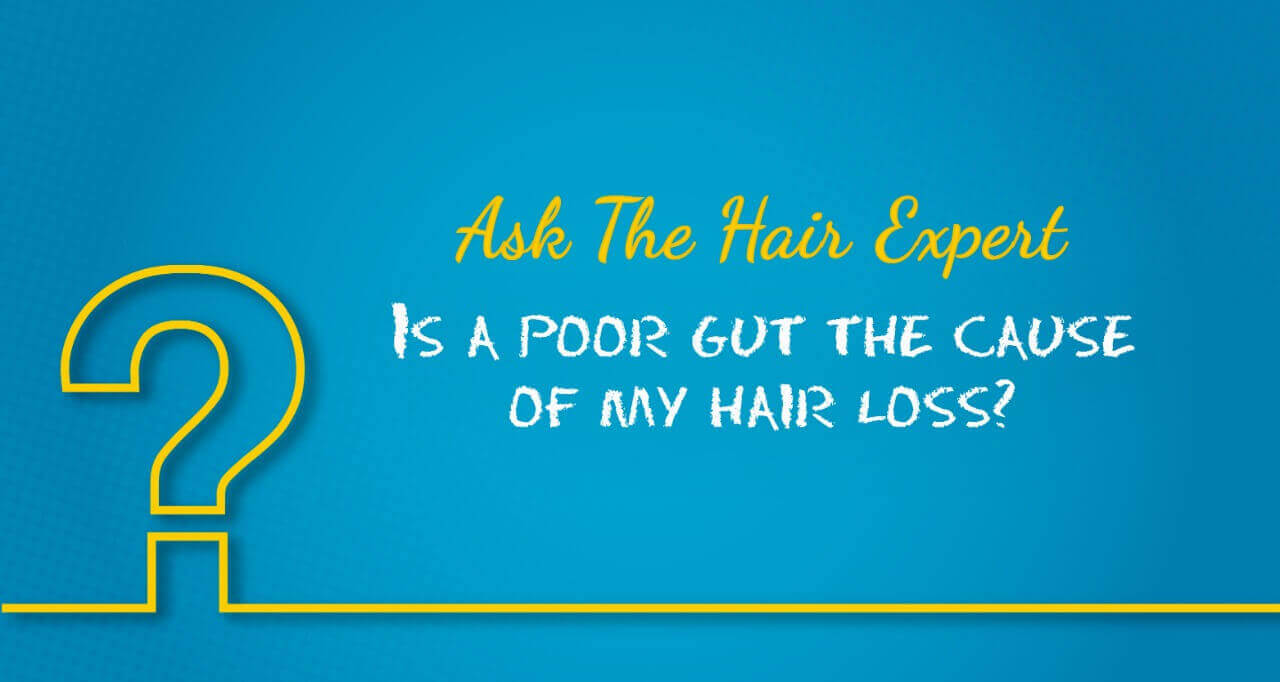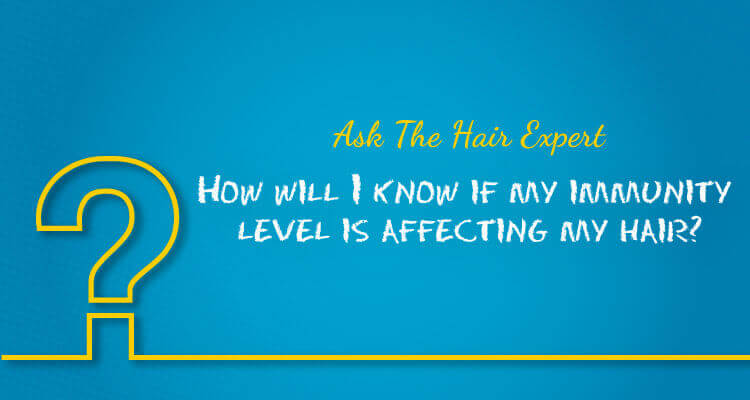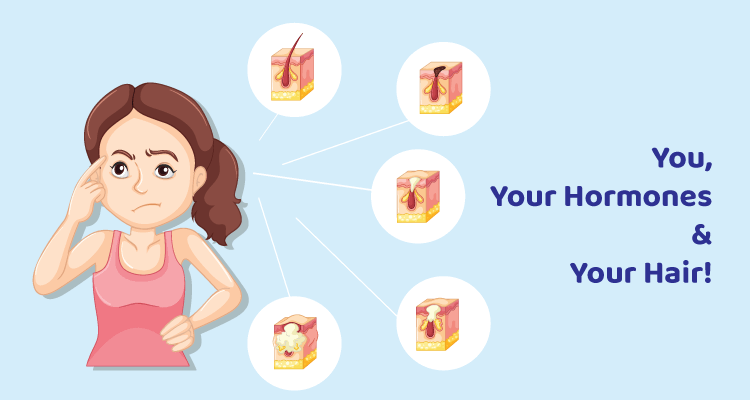What makes men and women go bald?
A question with multi-dimensional answers! Those of you who follow our blogs, know this! You would have read multiple pages on the topic!
Hair loss in men is a very common sight, right? Walk around any place and count the number of guys you see with a receding hairline! Research has shown that about as high as 85% of men face major hair thinning issues by the time they’re 50. Some, unfortunately, start to lose theirs even before they turn 21! A receding hairline is every man’s biggest problem, as is hair thinning or hair fall, a nightmare for women.
What if we told you, that there is something in our body, in all of us, that can trigger the death of hair follicles.
One of the biggest enemies to your hair is something that is within you, DHT – dihydrotestosterone, a hormone that, unfortunately, apart from its primary function, causes hair follicles to miniaturise. It is perhaps the common contributor to male and female pattern thinning. Its effect is more pronounced in males, while it affects women who have a history of hormonal fluctuations. Women who use oral contraceptives in an unchecked way are also prone to such hormonal imbalances.
Interestingly, for men, DHT is the most important hormone as it ensures hair growth in other parts of the body! It is this same hormone that is responsible for the growth of hair on your chest, back and other areas as a male. And it is the same one that causes male pattern baldness!
Let us understand this culprit better in order to tackle the issue effectively. ‘Cos the good news is, hair loss caused by DHT is treatable!
What is DHT?
Dihydrotestosterone (DHT) is a sex hormone, which is basically a derivative of testosterone. It is produced naturally in the body and plays a significant role in developing certain masculine characteristics such as facial and body hair, prostate, muscle growth, and a deeper voice. It is this hormone that is responsible for the formation of the male genitalia during pregnancy.
This hormone is present in both males and females, with the levels being different in each and thereby impacting each at different intensities.
How does DHT affect your hair?
Your body generates DHT as a byproduct of testosterone. A certain enzyme, the 5α-Reductase, converts a certain proportion of your testosterone into DHT. If you are genetically susceptible, then this DHT binds the receptors in your hair follicles, on your scalp and leads to their miniaturisation. The follicles get weakened, shrink and eventually can die. And as you know, with the death of a hair follicle, that particular hair’s growth cycle comes to an end!
Some research and studies have proved that it’s not the amount of testosterone that’s circulating which creates the concern, but it is the DHT, binding to those receptors in scalp follicles, that’s the culprit. DHT can shrink a hair follicle so much making it almost impossible for it to survive.
Does it affect only men?
This process of testosterone converting to DHT occurs in both men and women. However, under normal conditions, a woman will just have a minute fraction of the level of testosterone that a man would have. Now when this condition changes, and if there is a rise of DHT in her body, she will face hair loss. Studies have shown that even a lower level of DHT can trigger hair loss in women.
So, what happens when the DHT levels go off the charts?
Now while we don’t have to worry about DHT, if it reaches excessive levels, it leads to hair loss. High levels, of this hormone form, blocks essential nutrients from reaching your hair follicles. Whether it is the percentage of testosterone getting converted to DHT going high, or the testosterone levels in itself going high – both are of concern!
If you want your hair to remain unaffected and continue to grow through its cycle, you will basically need to ensure that the DHT levels are kept balanced.
What does ‘balance’ here mean? Men and women have both male and female hormones. And the hormones, as you know, operate best when they are in balance – as delicate as that is in most cases! Now, even when the male hormones, the androgens, are at normal levels, if there is a dip in its counterpart – the female estrogenic hormones – this triggers the rise in DHT. This imbalance causes hair loss, amongst other concerns.
Any hormonal imbalance, as you have learned about say thyroid disorder or pregnancy or postpartum, greatly influences the hair’s growth cycle and the phases within it. And as with the hair growth cycle, hormones too undergo a cyclical pattern. Testosterone in some men is known to drop each decade once he crosses 30. Women’s hormone levels change with each milestone such as puberty, pregnancy, postpartum and especially at menopause and beyond when there is a sharp dip.
The cyclical nature of both hormones and the hair growth cycle makes it tricky to maintain a balance indeed! What you need is a discipline with your lifestyle, diet and hair care routine, to ensure you are able to pull through all those milestones without any major concern. And seek professional help when it is needed, without hesitation.
What kind of hair loss does DHT trigger? What to watch out for?
Androgenic or androgenetic alopecia, commonly known as male or female pattern thinning or hair loss, is the usual type of hair loss that is seen triggered by DHT. This hair loss is pronounced in those genetically susceptible to the condition.
In women, this kind of hormonal hair loss renders itself in a different pattern from how it happens in men. While with MPT, a horseshoe-like receding hairline pattern is observed, in women with FPT, there is diffuse thinning of hair across the entire scalp. And a woman will not have the receding frontal hairline as men do.
Female pattern baldness progresses somewhat as mentioned below,
- There is diffuse hair loss across all sections of the scalp.
- Thinning starts on the top portion of your head, around the hair partition.
- The hair partition starts widening, showing off the increased thinning.
- The hair thinning progresses and results in scalp becoming visible in portions.
- The stages are measured using the Ludwig Scale, which grades the severity of female-pattern hair loss. On reaching stage 3 on this scale, it becomes difficult to regain hair.
Male pattern baldness progresses as follows,
- It starts with the thinning of hair around the temples. There is a very slight recession that often goes unnoticed or ignored. The hairline recedes slightly above the upper brow crease on your forehead.
- The hairline at the temples moves further inward, creating a M shaped hairline. When this progresses, there will be little or no hair in the temporal region.
- The hair at the crown thins out and there is hair loss at the vertex, at the back of the head or in front of the head.
- The hairline then starts to show signs of the typical horseshoe-shape, associated with MPT.
- Hairline then creeps up to the top of your head. There is little hair remaining on your crown, and it is very thin and fine.
- If left unattended until after this stage, the head goes completely bald. The stages are accurately diagnosed using the Norwood scale.
In both cases, in case of advanced stages, hair transplant or wearing a hair system is a good option.
For others, the earlier you tend to the symptoms, the options available to regain hair is more. This brings us to question whether one can regain hair or reverse the hair loss caused by the effects of DHT…
Is hair loss triggered by DHT treatable?
Yes, it is. Also, hair loss isn’t overnight. While it can indeed be rapid, there will be enough signs for you to take note of and pay attention to.
While the hair loss may be triggered by DHT there are factors that contribute to the problem, like nutritional and immune system deficiencies, crash dieting leading to sudden weight loss, emotional or physical stress, unhealthy lifestyle, other hormonal issues like thyroid disorders, PCOD, etc.
Here are some relatable symptoms you can watch out for:
- Excessive hair fall, does it seem to be more than usual?
- Change in hairline? Perhaps compare your clicks over the past year or two…check for a pattern!
- Noticeably less volume of hair?
- Hair thinning or hair loss?
If you are facing any of the above, it is time for you to get yourself diagnosed for the exact root cause of the issue.
DHT triggered hair thinning and hair loss is reversible. If it is identified as the primary cause, then there are DHT blockers that are used to tackle it. There are normally two lines of treatments looked at,
a) Pharmaceutical DHT blockers, OR
b) Natural DHT blockers.
Studies and research that indicated that patients using pharmaceutical DHT blockers exhibit signs of sexual dysfunction, in many cases. Hence, the majority of Trichologists encourage the use of natural DHT blocker treatment.
Many opt for Minoxidil as a topical solution to hair loss. However what happens is that while it can stimulate hair growth, and may prolong the anagen phase of your hair cycle, the new hairs that grow are most likely to be very thin and weak. Its use does not cure baldness. Minoxidil doesn’t actually address the root cause – DHT. While you may see some temporary relief, it is not your long term solution to address this kind of hair loss effectively. Blocking DHT is the best way to address the hair loss triggered by it.
Herbal DHT blockers such as pygeum bark, pumpkin seeds, grape seed extracts and green tea are widely recognised as being very effective in tackling hair loss. These natural blockers help reduce the production of DHT from Testosterone, thereby helping to slow down the process of balding.
In women, natural treatment for baldness is preferred as hormone replacement therapy and pharmaceutical DHT blockers have side effects. Dong Quai Complex, made from a plant called Dong Quai, in combination with Black Cohosh and Megafemme tablets, which are made from a Peruvian herb, have natural estrogen and show effective results when hair thinning occurs due to low levels of estrogen. Further, some foods such as soy, flaxseeds, walnuts and yam show oestrogenic properties and offer great support to baldness treatment. In men, again, natural DHT blockers are advised, instead of minoxidil.
Plant Stem Cell treatments to tackle hair thinning and hair loss
You now have remarkable plant stem cell based technology and tricho treatments that serve well in treating the kind of hair loss and hair thinning we are discussing today. These treatments effectively block DHT, thereby tackling your root cause, nipping the problem at the bud.
For instance, Anagain, the first-ever hair fertility treatment for men, uses as an extract from basil that inhibits 5α reductase and stimulates hair follicles. It activates the Dermal Papilla (a “ball” of specialised dermal cells) and the hair follicle is pushed back into the growth phase with this therapy. It can control hair thinning by controlling 5α-Reductase and improve the hair anagen phase by shortening telegenic or rather very specifically exogen. Similarly, there is Anagrow treatment for women, to tackle hair thinning. This again uses powerful plant stem cell extracts to revive the hair follicles, prolong the life cycle of hair and increases growth and help it function to its full potential.
What these treatments do for you,
- Stimulates hair growth at the root
- Prolongs the life cycle of hair
- Fully restores the vitality of the hair
- Helps make hair denser
- Combats hair thinning
- Controls hair loss
- Restores hair regeneration
Further, when you undergo such treatments you are also advised a balanced diet, including some supplements like B vitamins including biotin, ginseng, zinc, rosemary, pumpkin seed, and chamomile to name a few. Some vegetables that are rich in zinc block DHT production. Spinach, tomatoes, watermelons, carrots, and mangoes are also known to naturally block DHT. Do read our blog on what kind of diet would be great for your hair.
There are many DHT blocking hair products in the market. But we wouldn’t readily recommend them as they are typically those that offer only temporary relief. You can always check with your trichologist if you wish to use one. He/she can help you decipher all that fine print on the product packaging and what they mean for your hair!
Your trichologist may also suggest lifestyle changes, if necessary. A healthy lifestyle will naturally reduce DHT levels. Regular exercise, activities to reduce stress, ensuring good sleep, quitting smoking and a disciplined hair care routine can all help curtail the damage.
Alternate options to restore your hair?
The other options available to someone dealing with MPT and FPT are hair transplant and/or use of hair systems, which are highly evolved and lets you follow your lifestyle as is – no restrictions!
Surgical Hair transplant is a way of permanent hair restoration. Do read our blogs to understand all about hair transplants and if it is the right way forward for you.
Hair Systems are another alternative. It is perhaps the most convenient way to restore hair non-surgically. It is non-invasive, hassle-free and undetectable. Non-surgical hair replacement procedure allows you to achieve a head full of hair that looks natural, stylish and does not restrict your lifestyle. Understand Hair systems better by catching up on our blogs on the subject.
We trust that we have explained DHT and related hair loss in simple terms! As you can see, there are enough and more options to deal with hair problems. You just need to look at it scientifically and get to the root cause. And let us remind you, that a good hair care routine and balanced diet can take care of most hair issues! A regular tricho check can give you the assurance you are looking for, on whether you are on the right track to great hair every day!
With that, we sign off for now! Remember, we are just a call away for any questions!
For all things ‘Hair’, do follow our blogs on hair loss, hair care, treatments, and interesting hair trivia!
Connect with us on social media on the links below. Do leave your questions & comments and we will address them all!



